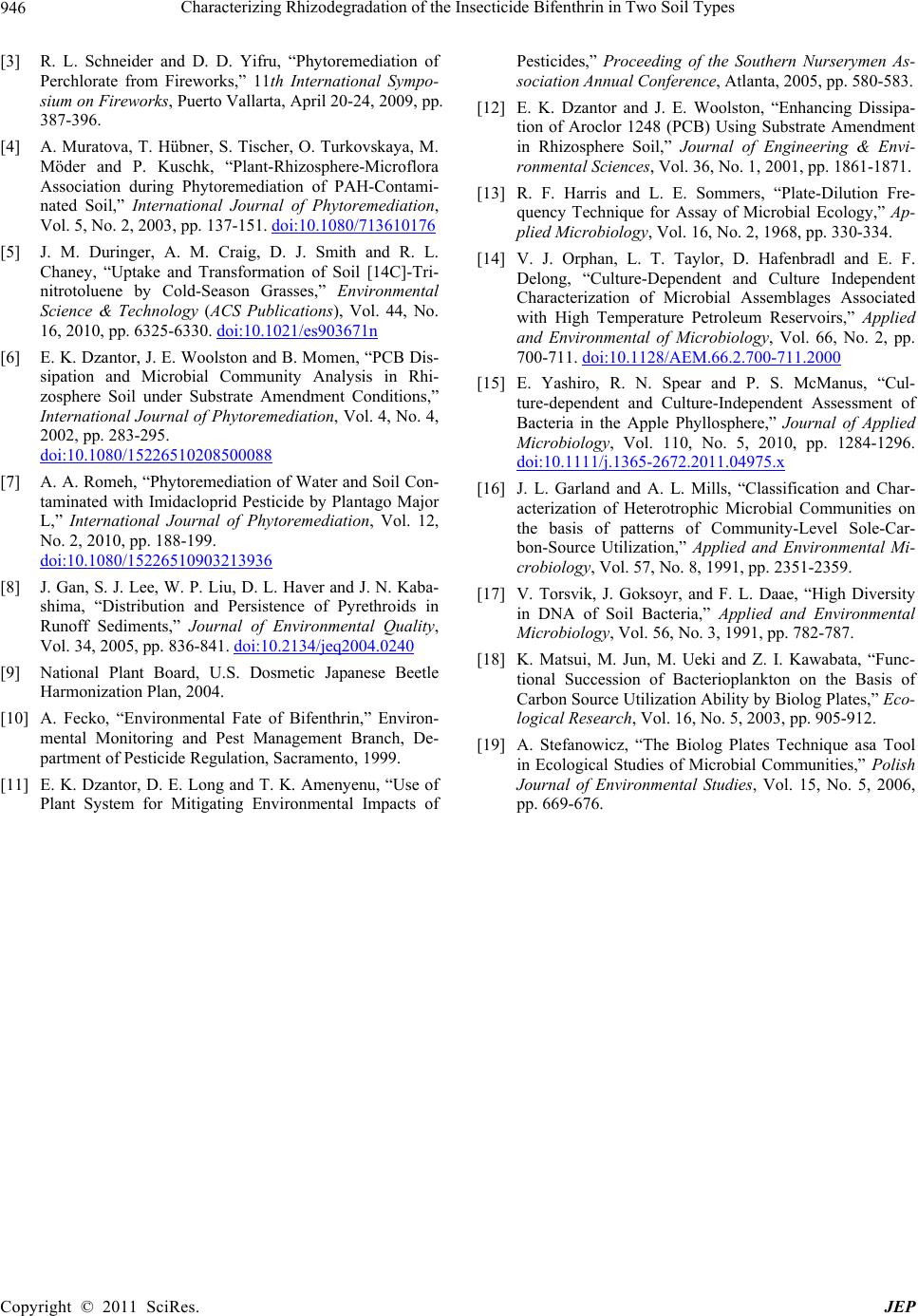
Characterizing Rhizodegradation of the Insecticide Bifenthrin in Two Soil Types
Copyright © 2011 SciRes. JEP
946
[3] R. L. Schneider and D. D. Yifru, “Phytoremediation of
Perchlorate from Fireworks,” 11th International Sympo-
sium on Fireworks, Puerto Vallarta, April 20-24, 2009, pp.
387-396.
[4] A. Muratova, T. Hübner, S. Tischer, O. Turkovskaya, M.
Möder and P. Kuschk, “Plant-Rhizosphere-Microflora
Association during Phytoremediation of PAH-Contami-
nated Soil,” International Journal of Phytoremediation,
Vol. 5, No. 2, 2003, pp. 137-151. doi:10.1080/713610176
[5] J. M. Duringer, A. M. Craig, D. J. Smith and R. L.
Chaney, “Uptake and Transformation of Soil [14C]-Tri-
nitrotoluene by Cold-Season Grasses,” Environmental
Science & Technology (ACS Publications), Vol. 44, No.
16, 2010, pp. 6325-6330. doi:10.1021/es903671n
[6] E. K. Dzantor, J. E. Woolston and B. Momen, “PCB Dis-
sipation and Microbial Community Analysis in Rhi-
zosphere Soil under Substrate Amendment Conditions,”
International Journal of Phytoremediation, Vol. 4, No. 4,
2002, pp. 283-295.
doi:10.1080/15226510208500088
[7] A. A. Romeh, “Phytoremediation of Water and Soil Con-
taminated with Imidacloprid Pesticide by Plantago Major
L,” International Journal of Phytoremediation, Vol. 12,
No. 2, 2010, pp. 188-199.
doi:10.1080/15226510903213936
[8] J. Gan, S. J. Lee, W. P. Liu, D. L. Haver and J. N. Kaba-
shima, “Distribution and Persistence of Pyrethroids in
Runoff Sediments,” Journal of Environmental Quality,
Vol. 34, 2005, pp. 836-841. doi:10.2134/jeq2004.0240
[9] National Plant Board, U.S. Dosmetic Japanese Beetle
Harmonization Plan, 2004.
[10] A. Fecko, “Environmental Fate of Bifenthrin,” Environ-
mental Monitoring and Pest Management Branch, De-
partment of Pesticide Regulation, Sacramento, 1999.
[11] E. K. Dzantor, D. E. Long and T. K. Amenyenu, “Use of
Plant System for Mitigating Environmental Impacts of
Pesticides,” Proceeding of the Southern Nurserymen As-
sociation Annual Conference, Atlanta, 2005, pp. 580-583.
[12] E. K. Dzantor and J. E. Woolston, “Enhancing Dissipa-
tion of Aroclor 1248 (PCB) Using Substrate Amendment
in Rhizosphere Soil,” Journal of Engineering & Envi-
ronmental Sciences, Vol. 36, No. 1, 2001, pp. 1861-1871.
[13] R. F. Harris and L. E. Sommers, “Plate-Dilution Fre-
quency Technique for Assay of Microbial Ecology,” Ap-
plied Microbiology, Vol. 16, No. 2, 1968, pp. 330-334.
[14] V. J. Orphan, L. T. Taylor, D. Hafenbradl and E. F.
Delong, “Culture-Dependent and Culture Independent
Characterization of Microbial Assemblages Associated
with High Temperature Petroleum Reservoirs,” Applied
and Environmental of Microbiology, Vol. 66, No. 2, pp.
700-711. doi:10.1128/AEM.66.2.700-711.2000
[15] E. Yashiro, R. N. Spear and P. S. McManus, “Cul-
ture-dependent and Culture-Independent Assessment of
Bacteria in the Apple Phyllosphere,” Journal of Applied
Microbiology, Vol. 110, No. 5, 2010, pp. 1284-1296.
doi:10.1111/j.1365-2672.2011.04975.x
[16] J. L. Garland and A. L. Mills, “Classification and Char-
acterization of Heterotrophic Microbial Communities on
the basis of patterns of Community-Level Sole-Car-
bon-Source Utilization,” Applied and Environmental Mi-
crobiology, Vol. 57, No. 8, 1991, pp. 2351-2359.
[17] V. Torsvik, J. Goksoyr, and F. L. Daae, “High Diversity
in DNA of Soil Bacteria,” Applied and Environmental
Microbiology, Vol. 56, No. 3, 1991, pp. 782-787.
[18] K. Matsui, M. Jun, M. Ueki and Z. I. Kawabata, “Func-
tional Succession of Bacterioplankton on the Basis of
Carbon Source Utilization Ability by Biolog Plates,” Eco-
logical Research, Vol. 16, No. 5, 2003, pp. 905-912.
[19] A. Stefanowicz, “The Biolog Plates Technique asa Tool
in Ecological Studies of Microbial Communities,” Polish
Journal of Environmental Studies, Vol. 15, No. 5, 2006,
pp. 669-676.